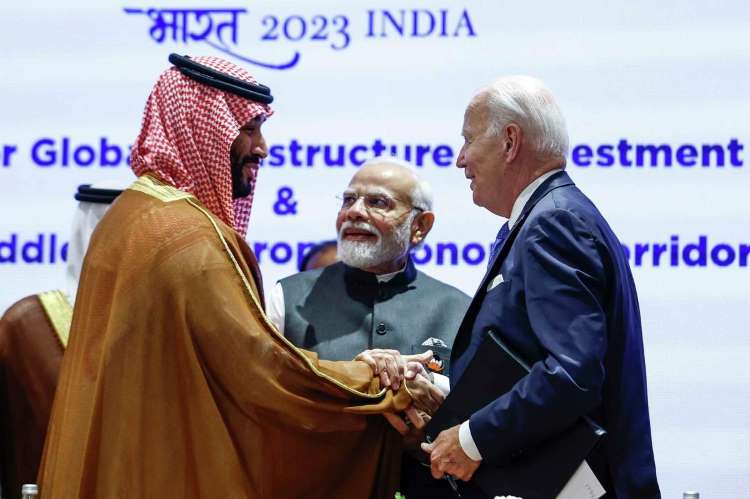
The recent G20 Summit in Delhi unveiled the vision for an India-Middle East-Europe Economic Corridor (IMEC). This historic initiative aims to bolster economic, trade, and environmental ties across these regions. A memorandum of understanding was jointly announced by India, the United States, Saudi Arabia, the United Arab Emirates (UAE), France, Germany, Italy, and the European Union.
The IMEC is viewed as a counter to China’s Belt and Road Initiative (BRI), dubbed China’s Marshall Plan. Approximately 147 countries, representing two-thirds of the global population and 40% of global GDP, have shown interest or committed to the BRI. India, however, abstained, citing sovereignty concerns over the Pakistan Economic Corridor (CPEC) passing through Pakistan occupied Kashmir.
China’s launch of the BRI, followed by the establishment of the Asian Infrastructure Investment Bank (AIIB) in 2015, signalled its geo-political and geo-economic aspirations. This led to reservations among the US and its allies in Europe and Asia. This the question arises – Can IMEC effectively counterbalance China’s BRI?
The proposed IMEC incorporates two primary routes: the Eastern Corridor, connecting India to the Middle East, and the Northern Corridor, linking the Middle East to Europe. This network will incorporate railways, a hydrogen pipeline, and a high-capacity optical fibre network. By optimising transportation costs, these multimodal transport links are projected to enhance supply chain efficiency. Such corridors are envisioned with goals of cost and time savings, increased reliability, security, and expanded transportation capability.
Initial government estimates suggest that the IMEC could reduce goods transportation costs to Europe by 40% and save approximately 30% in time. Nevertheless, challenges remain, particularly in areas like infrastructure development, diplomatic coordination, and mutual interests.
READ I OPS vs NPS: Reviving the old pension scheme could spell fiscal doom
IMEC vs BRI
While the BRI is often seen as a reflection of China’s growing influence and potential vehicle for regional development and military expansion, it has encountered obstacles. Nearly 10 years on, many participating countries have faced economic challenges, with some, like Italy, reconsidering their involvement. In this context, major US allies in the Middle East, Europe, and India view IMEC as a counter to China’s BRI. The IMEC seeks to strengthen connectivity, boost manufacturing, support clean energy, and enhance food security in the participating regions.
Over time, while the US seeks to lessen its energy dependency on the Middle East, China has fostered deeper ties with the GCC nations and Iran. The IMEC, traversing West Asia, comes at a time when China’s presence is growing in the region, highlighted by a recent agreement facilitated by Beijing between Saudi Arabia and Iran. The Gulf holds significance for India, being a primary energy supplier and residence for nearly 9 million Indian expatriates.
The 2020 Abraham Accord between Israel and UAE, along with potential Israel-Saudi Arabia relations, also impact India. The US has also been involved in coalitions perceived as anti-China, like the QUAD (US, India, Australia, Japan) and AUKUS (USA, Australia, UK). The US, India, UAE, and Israel are part of the I2U2, often referred to as the West Asian Quad. While IMEC offers India economic advantages, the US sees it as a means to counter China’s geo-economic clout, especially after China surpassed the US as the EU’s largest trading partner.
IMEC promises economic growth through better connectivity, cost reductions, and streamlined trade transactions. It could allow India to utilise European infrastructure, improving trade efficiency. Approximately 11% of India’s trade is with Europe, worth around 88 billion Pounds. IMEC’s potential benefits include simplified documentation processes for smoother transit. The corridor could also help diversify India’s trade, currently concentrated with China and the US.
An ICRIER study suggests that by 2030, IMEC could boost India’s trade with the Middle East and Europe by up to $200 billion. IMEC’s unique selling point might be its environmental angle, potentially exporting green hydrogen to reduce carbon footprints. However, its success hinges on adept diplomacy and the aligned interests of participating nations. It is crucial to heed lessons from China’s BRI.
(Ashok Alex Luke is Assistant Professor, Department of Political Science, CMS College, Kottayam. Parvathy NN is a post-graduate student at the Department of Applied Economics, Cochin University of Science and Technology. Aswathy Rachel Varughese is Assistant Professor, Department of Applied Economics, Cochin University of Science and Technology.)
Dr. Aswathy Rachel Varughese is Assistant Professor at Gulati Institute of Finance and Taxation, Thiruvananthapuram, Kerala.

